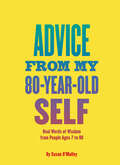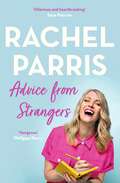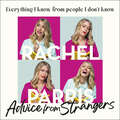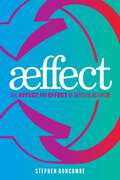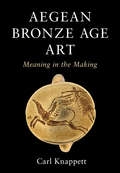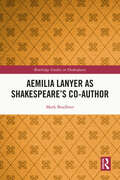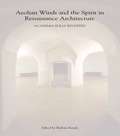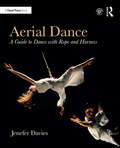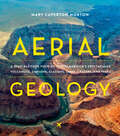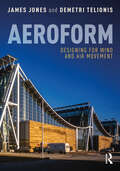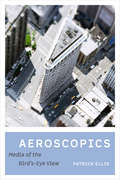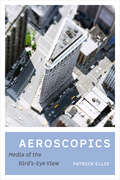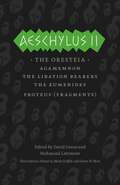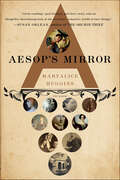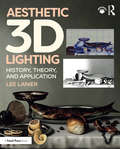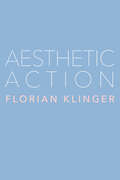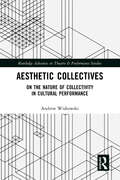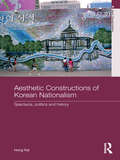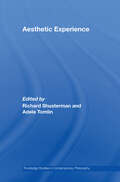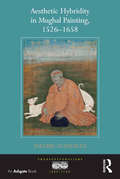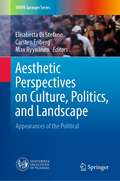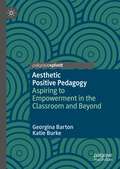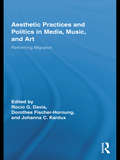- Table View
- List View
Advice from My 80-Year-Old Self: Real Words of Wisdom from People Ages 7 to 88
by Susan O'Malley“The voices gathered here display incredible wit, sincerity, and generosity; we are lucky to be able to listen to them.” —ArtforumIf you had the opportunity to meet your eighty-year-old self, what do you think she/he would tell you?That is the question artist Susan O’Malley, who was herself to die far too young, asked more than a hundred ordinary people of every age, from every walk of life. She then transformed their responses into vibrant text-based images. From a prompt to do things that matter to your heart, to a reminder that it’s okay to have sugar in your tea, these are calls to action and words to live by—heartfelt, sometimes humorous, and always fiercely compassionate. This stirring celebration of our collective humanity unveils the wisdom we hold inside ourselves right now.“Everyone, regardless of age, can take something away from this uplifting work.” —Real Simple
Advice from Strangers: Everything I know from people I don't know
by Rachel Parris'Warm witty and wise.' --RICHARD OSMAN'Hilarious, wise and heart breaking. Like an all-night over-share with your best friend.' --SARA PASCOE'Rachel is one of my favourite comedians. This book is warm, wise and hilarious. It is written in her comic voice - a voice she mainly has used to tell me off, so I am thrilled to see it deployed in this way.' --NISH KUMAR'The most joyful bursts of wisdom from a truly funny soul. I adore this book.' --CARIAD LLOYD'Hilarious, original and wise. This is essential reading.' --ELLIE TAYLOR'Rachel is one of the wisest, funniest people I know. Funny, sad, beautiful and ridiculous, Advice from Strangers has it all.' --PIPPA EVANS'A hilarious, fiery, reassuring hug of a book. Full of laughter, compassion and feminist wisdom.' --FRAN BUSHE'An essential, hilarious handbook for life.' --ATHENA KUGBLENUCOMEDIAN RACHEL PARRIS WAS ASKED TO GIVE AN INSPIRING GRADUATION SPEECH. WHO DID SHE ASK FOR ADVICE? TOTAL STRANGERS...Over the course of a year award-winning comedian Rachel Parris asked members of her live audience for advice. Here she takes those random bits of wisdom - such as 'Be Kind' or 'Never Pass Up the Opportunity for a Wee' - and explores them in ways that are funny and serious, hilarious and heart-breaking. This uplifting feminist manifesto of a book outlines the essentials of living in the modern world; dealing with everything from Tampons to Tories and from #hashtags to Staying Hydrated.
Advice from Strangers: Everything I know from people I don't know
by Rachel Parris'Warm witty and wise.' --RICHARD OSMAN'Hilarious, wise and heart breaking. Like an all-night over-share with your best friend.' --SARA PASCOE'Rachel is one of my favourite comedians. This book is warm, wise and hilarious. It is written in her comic voice - a voice she mainly has used to tell me off, so I am thrilled to see it deployed in this way.' --NISH KUMAR'The most joyful bursts of wisdom from a truly funny soul. I adore this book.' --CARIAD LLOYD'Hilarious, original and wise. This is essential reading.' --ELLIE TAYLOR'Rachel is one of the wisest, funniest people I know. Funny, sad, beautiful and ridiculous, Advice from Strangers has it all.' --PIPPA EVANS'A hilarious, fiery, reassuring hug of a book. Full of laughter, compassion and feminist wisdom.' --FRAN BUSHE'An essential, hilarious handbook for life.' --ATHENA KUGBLENUCOMEDIAN RACHEL PARRIS WAS ASKED TO GIVE AN INSPIRING GRADUATION SPEECH. WHO DID SHE ASK FOR ADVICE? TOTAL STRANGERS...Over the course of a year award-winning comedian Rachel Parris asked members of her live audience for advice. Here she takes those random bits of wisdom - such as 'Be Kind' or 'Never Pass Up the Opportunity for a Wee' - and explores them in ways that are funny and serious, hilarious and heart-breaking. This uplifting feminist manifesto of a book outlines the essentials of living in the modern world; dealing with everything from Tampons to Tories and from #hashtags to Staying Hydrated.
Advice from Strangers: Everything I know from people I don't know
by Rachel ParrisCOMEDIAN RACHEL PARRIS WAS ASKED TO GIVE AN INSPIRING GRADUATION SPEECH. WHO DID SHE ASK FOR ADVICE? TOTAL STRANGERS...Over the course of a year award-winning comedian Rachel Parris asked members of her live audience for advice. Here she takes those random bits of wisdom - such as 'Be Kind' or 'Never Pass Up the Opportunity for a Wee' - and explores them in ways that are funny and serious, hilarious and heart-breaking. This uplifting feminist manifesto of a book outlines the essentials of living in the modern world; dealing with everything from Tampons to Tories and from #hashtags to Staying Hydrated. (P) 2022 Hodder & Stoughton Limited
Aeffect: The Affect and Effect of Artistic Activism
by Stephen DuncombeThe first book to seriously identify how artistic activism works and how to make it work betterThe past decade has seen an explosion in the hybrid practice of “artistic activism,” as artists have turned toward activism to make their work more socially impactful and activists have adopted techniques and perspectives from the arts to make their interventions more creative. Yet questions haunt the practice: Does artistic activism work aesthetically? Does it work politically? And what does “working” even mean when one combines art and activism? In Æffect, author Stephen Duncombe sets out to address these questions at the heart of the field of artistic activism.Written by the co-founder and current Research Director of the internationally recognized Center for Artistic Activism, Æffect draws on Duncombe’s more than twenty-five years of experience in the field and one hundred in-depth interviews with artistic activists worldwide. More than a mere academic exercise, the theory, research, and tools in this book lay the groundwork for artistic activists to evaluate and strengthen their practice and to create better projects. The exploration of good artistic activism is grounded in three sets of concerns. 1) Change: Upon what theories of change is artistic activism based? 2) Intention: What do we hope and expect artistic activism to do, and how does it do this? 3) Evaluation: What actually happens as the result of an artistic activist intervention? Can it be measured?Æffect is rich with examples that demonstrate successful artistic activism, including Undocubus, an old bus painted “No Fear” across its side that was driven cross-country by a group of undocumented immigrant activists; Journal Rappé, a video show created by Senegalese rappers who created long-form investigative reports by rapping the current news in French and Wolof; and War on Smog, a staged a public performance piece by artistic activists in the city of Chongqing in Southwest China. Scannable QR codes are included to provide tools that help readers assess the æffect of their artistic activism.
Aegean Bronze Age Art: Meaning in the Making
by Carl KnappettHow do we interpret ancient art created before written texts? Scholars usually put ancient art into conversation with ancient texts in order to interpret its meaning. But for earlier periods without texts, such as in the Bronze Age Aegean, this method is redundant. Using cutting-edge theory from art history, archaeology, and anthropology, Carl Knappett offers a new approach to this problem by identifying distinct actions - such as modelling, combining, and imprinting - whereby meaning is scaffolded through the materials themselves. By showing how these actions work in the context of specific bodies of material, Knappett brings to life the fascinating art of Minoan Crete and surrounding areas in novel ways. With a special focus on how creativity manifests itself in these processes, he makes an argument for not just how creativity emerges through specific material engagements but also why creativity might be especially valued at particular moments.
Aemilia Lanyer as Shakespeare’s Co-Author (Routledge Studies in Shakespeare)
by Mark BradbeerThis book presents original material which indicates that Aemilia Lanyer – female writer, feminist, and Shakespeare contemporary – is Shakespeare’s hidden and arguably most significant co-author. Once dismissed as the mere paramour of Shakespeare’s patron, Lord Hunsdon, she is demonstrated to be a most articulate forerunner of #MeToo fury. Building on previous research into the authorship of Shakespeare’s works, Bradbeer offers evidence in the form of three case studies which signal Aemilia’s collaboration with Shakespeare. The first case study matches the works of "George Wilkins" – who is currently credited as the co-author of the feminist Shakespeare play Pericles (1608) – with Aemilia Lanyer’s writing style, education, feminism and knowledge of Lord Hunsdon’s secret sexual life. The second case-study recognizes Titus Andronicus (1594), a play containing the characters Aemilius and Bassianus, to be a revision of the suppressed play Titus and Vespasian (1592), as authored by the unmarried pregnant Aemilia Bassano, as she then was. Lastly, it is argued that Shakespeare’s clowns, Bottom, Launce, Malvolio, Dromio, Dogberry, Jaques, and Moth, arise in her deeply personal war with the misogynist Thomas Nashe. Each case study reveals new aspects of Lanyer’s feminist activism and involvement in Shakespeare’s work, and allows for a deeper analysis and appreciation of the plays. This research will prove provocative to students and scholars of Shakespeare studies, English literature, literary history, and gender studies.
Aeolian Winds and the Spirit in Renaissance Architecture: Academia Eolia Revisited
by Barbara KendaWritten by scholars of international stature, Aeolian Winds and the Spirit in Renaissance Architecture presents studies of Renaissance pneumatology exploring the relationship between architecture and the disciplines of art and science. One of the principle goals of Renaissance architects was to augment the powers of pneuma so as to foster the art of well-being. Central to the study of pneumatic architecture are six Italian villas connected together by a ventilating system of caves and tunnels, including Eolia, in which Trento established an academic circle of scholars that included Palladio, Tazzo and Ruzzante. Picking up on current interest in environmental issues, Aeolian Winds and the Spirit in Renaissance Architecture reintroduces Renaissance perspectives on the key relationships in environmental issues between architecture and art and science. This beautifully illustrated and unprecedented study will illuminate the studies of any architecture or Renaissance student or scholar.
Aerial Dance: A Guide to Dance with Rope and Harness
by Jenefer DaviesAerial Dance: A Guide to Dance with Rope and Harness provides an introduction for the beginning aerialist. It covers rigging, equipment, advice on optimal conditioning, and a step-by-step guide to technique, including anatomical references, space and time considerations, and elements of force when working with and against gravity. Specific movements and choreography are framed anatomically and together reflect the pattern and order of an aerial technique class. Challenges inherent to this type of dancing are discussed, as well as wellness instruction and methods of altering these techniques for intermediate and advanced dancing. A companion website hosts video that corresponds with the technique and phrasing in the book.
Aerial Geology: A High-Altitude Tour of North America’s Spectacular Volcanoes, Canyons, Glaciers, Lakes, Craters, and Peaks
by Mary Caperton Morton“Get your head into the clouds with Aerial Geology.” —The New York Times Book ReviewAerial Geology is an up-in-the-sky exploration of North America’s 100 most spectacular geological formations. Crisscrossing the continent from the Aleutian Islands in Alaska to the Great Salt Lake in Utah and to the Chicxulub Crater in Mexico, Mary Caperton Morton brings you on a fantastic tour, sharing aerial and satellite photography, explanations on how each site was formed, and details on what makes each landform noteworthy. Maps and diagrams help illustrate the geological processes and clarify scientific concepts. Fact-filled, curious, and way more fun than the geology you remember from grade school, Aerial Geology is a must-have for the insatiably curious, armchair geologists, million-mile travelers, and anyone who has stared out the window of a plane and wondered what was below.
Aeroform: Designing for Wind and Air Movement
by James Jones Demetri TelionisAeroform: Designing for Wind and Air Movement provides a comprehensive introduction to applying aerodynamic principles to architectural design. It presents a challenge to architects and architectural engineers to give shape to the wind and express its influence on architectural form. The wind pushes and pulls on our buildings, infiltrates and exfiltrates through cracks and openings, and lifts roofs during storm events. It can also offer opportunities for resource conservation through natural ventilation or a biophilic connection between indoors and out. This book provides basic concepts in fluid mechanics such as materials, forces, equilibrium, pressure, and hydrostatics; introduces the reader to the concept of airflow; and provides strategies for designing for wind resistance, especially in preventing uplift. Natural ventilation and forced airflow are explored using examples such as Thomas Herzog’s Hall 26 in Hanover, RWE Ag building in Essen Germany, and the Kimbell Art Museum in Texas. Finally, issues of wind and airflow measurement are addressed. A reference for students and practitioners of architecture and architectural engineering, this book is richly illustrated and presents complex concepts of aerodynamic engineering in easy-to-understand language. It prepares the architect or architectural engineer to design buildings that are visually expressive of a dialogue between wind and built form.
Aeroscopics: Media of the Bird's-Eye View
by Patrick EllisIn 1900, Paris had no skyscrapers, no tourist helicopters, no drones. Yet well before aviation made aerial views more accessible, those who sought such vantages had countless options available to them. They could take in the vista from an observation ride, see a painting of the view from Notre-Dame, or overlook a miniature model city. In Aeroscopics, Patrick Ellis offers a history of the view from above, written from below. Richly illustrated and premised upon extensive archival work, this interdisciplinary study reveals the forgotten media available to the public in the Balloon Era and after. Ellis resurrects these neglected spectacles as "aeroscopics," opening up new possibilities for the history of aerial vision.
Aeroscopics: Media of the Bird's-Eye View
by Patrick EllisIn 1900, Paris had no skyscrapers, no tourist helicopters, no drones. Yet well before aviation made aerial views more accessible, those who sought such vantages had countless options available to them. They could take in the vista from an observation ride, see a painting of the view from Notre-Dame, or overlook a miniature model city. In Aeroscopics, Patrick Ellis offers a history of the view from above, written from below. Richly illustrated and premised upon extensive archival work, this interdisciplinary study reveals the forgotten media available to the public in the Balloon Era and after. Ellis resurrects these neglected spectacles as "aeroscopics," opening up new possibilities for the history of aerial vision.
Aeschylus II: The Oresteia (The Complete Greek Tragedies)
by AeschylusThis updated translation of the Oresteia trilogy and fragments of the satyr play Proteus includes an extensive historical and critical introduction. In the third edition of The Complete Greek Tragedies, Mark Griffith and Glenn W. Most have carefully updated the translations to bring them even closer to the ancient Greek while retaining their vibrancy for which the Grene and Lattimore versions are famous. New introductions for each play offer essential information about its first production, plot, and reception in antiquity and beyond.Each volume also includes an introduction to the life and work of the tragedian and an explanation of how the plays were first staged, as well as notes addressing textual uncertainties and a glossary of names and places mentioned in the plays. The result is a series of lively and authoritative translations offering a comprehensive introduction to these foundational works of Western drama.
Aesop's Mirror
by Maryalice Huggins"Everything I needed to know about Fox and Grapes mirror, I knew the moment I first saw it"What antiques restorer Maryalice Huggins knew when she stumbled across the mirror at a country auction in Rhode Island was this: She was besotted. Rococo and huge (more than eight feet tall), the mirror was one of the most unusual objects she had ever seen. Huggins had to have it.The frame's elaborate carvings were almost identical to a famous eighteenth-century design. Could this be eighteenth-century American? That would make it rare indeed. But in the rarefied world of American antiques, an object is not significant unless you can prove where it's from. Huggins set out to trace the origins of her magnificent mirror.Fueled with the delightfully obsessive spirit of Susan Orlean's The Orchid Thief, Aesop's Mirror follows Huggins on her quest as she goes up against the leading lights of the very male world of high-end antiques and dives into the historical archives. And oh, what she finds there! The mirror was likely passed down through generations of the illustrious Brown family of Providence, Rhode Island.Throughout history, mirrors have been seen as having mystical powers, enabling those who peer into them to connect the past and the future. In Aesop's Mirror, Maryalice Huggins does just that, creating a marvelous, one-of-kind book about a marvelous, one of-a-kind American treasure.
Aesthetic 3D Lighting: History, Theory, and Application
by Lee LanierAesthetic 3D Lighting: History, Theory, and Application delves into the history, the theory, and the practical and aesthetic application of lighting in the fine arts and 3D animation. In this book, animation industry veteran and lighting expert Lee Lanier examines the importance of lighting and its ability to communicate information to the viewer. Lee examines the history of lighting as applied to the fine arts, film, photography, and 3D animation. He discusses the use of light color, light location and direction, and light shadow types to recreate specific locations and to generate moods. He includes guides for successful lighting in 3D animation. Software-agnostic examples lead you through useful 3D lighting set-ups. Chapter-long case studies step you through more complex 3D lighting projects in Autodesk Maya. An accompanying eResource (www.routledge.com/9781138737570) features 3D model files, scene files, and texture bitmaps, allowing you to practice the discussed techniques in Autodesk Maya and many other 3D programs. The lighting techniques covered in this book include: History of lighting as used in the fine arts The scientific mechanisms of light Light types and light application in 3D programs Light qualities including shadows variations Basic and advanced 3D lighting approaches 1-, 2-, 3-point, naturalistic, and stylistic lighting techniques Replication of real-world lighting scenarios and locations Overview of advanced 3D lighting and rendering systems
Aesthetic Action
by Florian KlingerIn this new book, Florian Klinger gives readers a basic action-theoretical account of the aesthetic. While normal action fulfills a determinate concept, Klinger argues, aesthetic action performs an indeterminacy by suspending the action's conceptual resolution. Taking as examples work by Tino Sehgal, Kara Walker, Mazen Kerbaj, Marina Abramović, Cy Twombly, and Franz Kafka, the book examines indeterminacy in such instances as a walk that is at once leisurely and purposeful, a sound piece that is at once joyous and mournful and mechanical, or a sculpture that at once draws one in and shuts one out. Because it has irresolution as its point, aesthetic action presents itself as an unsettling of ourselves, our ways, our very sense of who we are. As performers of such action, we don't recognize one another as bearers of a shared human form as we normally would, but find ourselves tasked anew with figuring out what sharing a form would mean. In conversation with philosophers such as Kant, Hegel, Wittgenstein, and Anscombe; political thinkers such as Marx and Lorde; and contemporary interlocutors such as Michael Thompson, Sebastian Rödl, and Thomas Khurana, Klinger's book makes a case for a conception of the human form that systematically includes the aesthetic: an actualization of the form that is indeterminate and nevertheless rational. The book gives the project of Western philosophical aesthetics a long-overdue formulation for our present that aims to do justice to contemporary aesthetic production as it actually exists. It will appeal to those working in philosophy, art, and political thought.
Aesthetic Collectives: On the Nature of Collectivity in Cultural Performance (Routledge Advances in Theatre & Performance Studies)
by Andrew WiskowskiThis book focuses attention on groups of performing people that are unique aesthetic objects, the focus of an artist’s vision, but at the same time a collective being; a singular, whole mass that exists and behaves like an individual entity. This text explores this unique experience, which is far from rare or special. Indeed, it is pervasive, ubiquitous and has, since the dawn of performance, been with us. Surveying installation art from Vanessa Beecroft & Kanye West, Greek tragedy, back-up dancing groups and even the mass dance of clubbing crowds, this text examines and names this phenomenon: Aesthetic Collectives. Drawing on a range of methods of investigation spanning performance studies, acting theory, studies of atmosphere and affect and sociology it presents an intervention in the literature for something that has long deserved its own attention. This book will be of great interest to scholars, students and practitioners in performance studies, theatre, live art, sociology (particularly of groups and subcultures), cultural studies and cultural geography.
Aesthetic Constructions of Korean Nationalism: Spectacle, Politics and History (Asia's Transformations)
by Hong KalWhile most studies on Korean nationalism centre on textual analysis, Aesthetic Constructions of Korean Nationalism offers a different approach. It looks at expositions, museums and the urban built environment at particular moments in both colonial and postcolonial eras and analyses their discursive relations in the construction of Korean nationalism. By linking concepts of visual spectacle, urban space and governmentality, this book explores how such notions made the nation imaginable to the public in both the past and the present; how they represented a new modality of seeing for the state and contributed to the shaping of collective identities in colonial and postcolonial Korea. The author further examines how their different modes were associated with the change in governmentality in Korea. In addressing these questions, the book interprets the politics behind the culture of displays and shows both the continuity and the transformation of spectacles as a governing technology in twentieth-century Korea. Aesthetic Constructions of Korean Nationalism is a significant contribution to a study of the politics of visual culture in colonial and postcolonial Korea. The book will be of interest to students and scholars of Korean Studies, Culture and Heritage Studies and Asian Studies.
Aesthetic Experience (Routledge Studies in Contemporary Philosophy)
by Richard Shusterman Adele TomlinIn this volume, a team of internationally respected contributors theorize the concept of aesthetic experience and its value. Exposing and expanding our restricted cultural and intellectual presuppositions of what constitutes aesthetic experience, the book aims to re-explore and affirm the place of aesthetic experience--in its evaluative, phenomenological and transformational sense--not only in relation to art and artists but to our inner and spiritual lives.
Aesthetic Hybridity in Mughal Painting, 1526-1658 (Transculturalisms, 1400-1700)
by Valerie GonzalezThe first specialized critical-aesthetic study to be published on the concept of hybridity in early Mughal painting, this book investigates the workings of the diverse creative forces that led to the formation of a unique Mughal pictorial language. Mughal pictoriality distinguishes itself from the Persianate models through the rationalization of the picture’s conceptual structure and other visual modes of expression involving the aesthetic concept of mimesis. If the stylistic and iconographic results of this transformational process have been well identified and evidenced, their hermeneutic interpretation greatly suffers from the neglect of a methodologically updated investigation of the images’ conceptual underpinning. Valerie Gonzalez addresses this lacuna by exploring the operations of cross-fertilization at the level of imagistic conceptualization resulting from the multifaceted encounter between the local legacy of Indo-Persianate book art, the freshly imported Persian models to Mughal India after 1555 and the influx of European art at the Mughal court in the sixteenth and seventeenth centuries. The author's close examination of the visuality, metaphysical order and aesthetic language of Mughal imagery and portraiture sheds new light on this particular aspect of its aesthetic hybridity, which is usually approached monolithically as a historical phenomenon of cross-cultural interaction. That approach fails to consider specific parameters and features inherent to the artistic practice, such as the differences between doxis and praxis, conceptualization and realization, intentionality and what lies beyond it. By studying the distinct phases and principles of hybridization between the variegated pictorial sources at work in the Mughal creative process at the successive levels of the project/intention, the practice/realization and the result/product, the author deciphers the modalities of appropriation and manipulation of the heterogeneous elements. Her unique
Aesthetic Literacies in School and Work: New Pathways for Education (SpringerBriefs in Education)
by Georgina BartonThis book argues the importance of aesthetic literacies in learning and teaching in schools for future work. The study of aesthetics is critical in today’s learning, due to the increasingly complex ways in which we communicate meaning, such as through the presentation of texts and objects. The book provides educators, pre-service teachers, and students an in-depth understanding of aesthetic literacies in innovative spaces, including in philosophical literature, environmental spaces, curricula and classrooms. Using various theoretical frames from both the arts and literacy fields, this book shares relevant pedagogies, theorisations and contexts where aesthetic literacies are at the core of learning. It emphasises how improved knowledge of aesthetics and quality experiences in beauty are vital in aiding students and young children develop the necessary resilience and tolerance needed in today’s uncertain world.
Aesthetic Perspectives on Culture, Politics, and Landscape: Appearances of the Political (UNIPA Springer Series)
by Max Ryynänen Elisabetta Di Stefano Carsten FribergThis book investigates how we are involved in politically informed structures and how they appear to us. Following different approaches in contemporary aesthetics and cultural philosophy, such as everyday aesthetics, atmosphere and aestheticization, the contributions explore how embedded powers in politics, education, democracy, and landscape are analyzed through aesthetics.
Aesthetic Positive Pedagogy: Aspiring to Empowerment in the Classroom and Beyond
by Georgina Barton Katie BurkeThis book introduces and explores a new pedagogical approach, Aesthetic Positive Pedagogy (APP), for teachers and students in a variety of educational contexts. The book is built on the need for educational institutions and communities to seriously consider a strong positive approach to learning and teaching, ultimately leading to a better world. Based on pre-existing philosophies such as positive pedagogy and critical pedagogy, APP encourages teachers to carefully consider their language use as well as other modal resources in the classroom. Using aesthetic experience as a core to learning, teachers can embed an approach to learning and teaching that supports wellbeing and resilience as well as caring and compassionate citizenship in their students. The authors outline what an APP approach to learning and teaching looks, feels and sounds like in different educational contexts such as in schools and higher education, and explore how it might be implemented in face-to-face as well as online learning. The book’s findings will apply to postgraduate students and academics in education and the creative arts, as well as teachers and leaders in schools.
Aesthetic Practices and Politics in Media, Music, and Art: Performing Migration
by Rocío G. DavisThis volume analyzes innovative forms of media and music (art installations, television commercials, photography, films, songs, telenovelas) to examine the performance of migration in contemporary culture. Though migration studies and media studies are ostensibly different fields, this transnational collection of essays addresses how their interconnection has shaped our understanding of the paradigms through which we think about migration, ethnicity, nation, and the transnational. Cultural representations intervene in collective beliefs. Art and media clearly influence the ways the experience of migration is articulated and recalled, intervening in individual perceptions as well as public policy. To understand the connection between migration and diverse media, the authors examine how migration is represented in film, television, music, and art, but also how media shape the ways in which host country and homeland are imagined. Among the topics considered are new mediated forms for representing migration, widening the perspective on the ways these representations may be analyzed; readings of enactments of memory in trans- and inter-disciplinary ways; and discussions of globalization and transnationalism, inviting us to rethink traditional borders in respect to migration, nation states, as well as disciplines.
